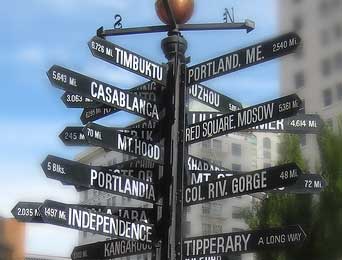Creating names can be one of the most challenging parts of creating a game setting. Sure, you can name things whatever happens to come to mind, but that can create names from all over the map (literally, if you’re borrowing names from the real world). You can end up with the Boxboggle river in the city of Sparrow Hill in the country of Wwoauntyz on Planet Q. While that kind of naming is common in the modern US, it doesn’t really help give players the feeling that your setting could be a real place.
 (Photo courtesy of http://www.flickr.com/photos/philliecasablanca/ / CC BY 2.0)
(Photo courtesy of http://www.flickr.com/photos/philliecasablanca/ / CC BY 2.0)
Another option is to use words that describe something about the area. For example, Meadowbrook or Razorback Wallow. This is often a good choice. Because you’re using names from one language (usually the language your group speaks), these names often have a more unified field. They feel as if they come from the same culture and they can give your players an idea of the culture of an area.
There’s a third option, though. You can create a naming language.
What’s a naming language?
Unlike creating a full speaking language (which can be fun, but takes a lot of time and energy investment), naming languages have a few simple rules and can be created in an evening. Your goal here isn’t to create an in-depth grammer and lexicon; it’s to create some rules about letter and sound patterns so that your names feel as if they all came from the same culture.
How to Create a Naming Language
Naming languages can be very simple to create. Creating full languages can involve creating new consonant and vowel sounds, as well as pronouns, grammar, sentence structure, standard word order … whew! Before you feel overwhelmed, remember that your sole purpose here is to create names. That’s it. You don’t need a complicated grammar or set of pronouns or whatnot. The names you’re creating don’t even have to mean anything (though they can, if you wish). You’re just looking for something that sounds internally consistent.
I’ve broken the process down into a series of steps, which I’ll cover next week over the course of several blog entries. These steps are:
- Decide what your language sounds like.
- Choose the most common sounds.
- Figure out the stress patterns of your names.
- Create tones.
- Determine sound constraints.
- Create an “alphabet” and pronunciation guide.
Other Sources
There are some excellent resources on line for creating languages, if you’d like more in-depth information. Here’s some of my favorites:
- Creating Languages. Notes for a psychology class offered UC Irvine.
- How to Create a Language. Just what it sounds like. Partially based on The Language Construction Kit (see below), this guide expands on various topics and provides more in-depth information.
- The Language Construction Kit. A brief step-by-step guide to creating an unique language.
- Other Worldly Places. A blog with many posts on language creation.
Related articles by Zemanta
- A Language Tree For My Setting from RPG Blog II (rpgblog2.com)
- Which is the most useful language for business after english? (startups.com)

![Reblog this post [with Zemanta]](http://img.zemanta.com/reblog_c.png?x-id=100d32fb-8229-4b74-b69d-3d10bbdab0d4)





One response to “What’s in a Name? Language!”